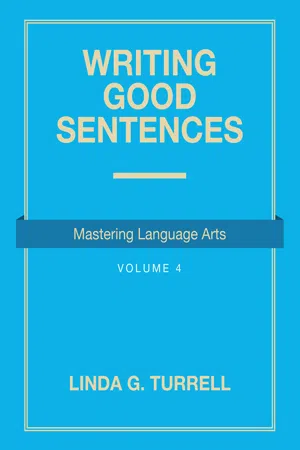
- 136 pages
- English
- ePUB (mobile friendly)
- Available on iOS & Android
About this book
Why read this book? This book walks you through the ten writing skills needed to master the art of writing good sentences. Whether it is the skill of crafting clear, logical, coherent, or vivid sentences, you will expand your skills. No matter where your experiences lead, you will have these skills:
1.Sentences types--simple, compound, and complex
2.Sentences--run-on and fragment
3.Sentence types--infinitive, participle, and appositive
4.Sentences--declarative, interrogative, imperative, exclamatory
5.Sentence word choice--choosing vivid words
6.Sentence logic--understanding cause and effect
7.Sharpening sentences
8.Expanding sentence meaning through description
9.Expanding sentence meaning using nouns
10.Expanding sentence meaning--using verbs
The ten steps explored in this book explain the process by examples, exercises, and reproducibles. These lessons will show you HOW to MASTER this skill.
It can be used both inside and outside the classroom by students and independent learners. The clear explanatory material is followed by reproducible activities that will help bring writing mastery. An answer key is included. This book is volume four of the MASTERING LANGUAGE ARTS SERIES. Volume one, WRITING GOOD STORIES, volume 2, EVERYDAY WRITING, and volume three, MASTERING PUNCTUATION, are companion books in the series.
This unique approach will help beginner writers, as well as writers who want to work on specific writing skills. This book is written by an award-winning instructor who has taught how to master many types of writing over the course of thirty years. She has published twenty-three books and fifteen professional articles, has been a state conference speaker, columnist, consultant, and instructional review columnist, and has served as a national judge for instructional media. And she is the holder of the TEXTY award given nationally for excellence in instructional writing. She was one of three in her category, and that series has been in print for twenty-three years used in classrooms across the nation. Linda G. Turrell has ten instructional books in two languages in 311 libraries worldwide.
Frequently asked questions
- Essential is ideal for learners and professionals who enjoy exploring a wide range of subjects. Access the Essential Library with 800,000+ trusted titles and best-sellers across business, personal growth, and the humanities. Includes unlimited reading time and Standard Read Aloud voice.
- Complete: Perfect for advanced learners and researchers needing full, unrestricted access. Unlock 1.4M+ books across hundreds of subjects, including academic and specialized titles. The Complete Plan also includes advanced features like Premium Read Aloud and Research Assistant.
Please note we cannot support devices running on iOS 13 and Android 7 or earlier. Learn more about using the app.
Information

- The writer wrote sloppily.
- The student talked softly.
- The student smiled sli...
Table of contents
- Sentence Types—Simple, Compound, Complex
- Sentence Run-Ons and Fragments
- Sentence Types—Infinitives, Participles, and Appositive Phrases
- Sentences—Declarative, Interrogative, Imperative, and Exclamatory
- Choosing Vivid Words for Sentences
- Writing Logical Sentences—Understanding Cause and Effect
- Sharpening Your Sentences
- Expanding Sentence Meaning through Description
- Expanding Sentences through Nouns
- Expanding Sentences Using Verbs